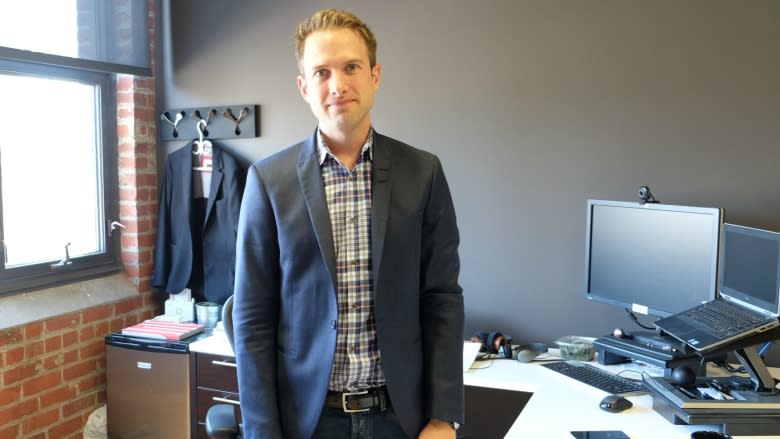Ubisoft Toronto celebrates 5th birthday and shows off bleeding-edge technology
You might notice something different about the old General Electric building in Toronto's Junction neighbourhood.
Running across the nearly century-old brickwork building, seen right next to a Canadian flag and the old water tower, is the logo for their primary tenant, the video game giant Ubisoft.
The prominent lettering was added in part to celebrate Ubisoft Toronto's fifth anniversary.
Ubisoft, the Paris-based games developer and publisher with 26 studios in 18 countries, invested more than $500 million to kickstart the Toronto studio. The Ontario government also pitched in $263 million, hinging on the promise of creating 800 jobs by 2020.
Seeded by a core group of developers and producers from the company's flagship Montreal studio, the Toronto location has since grown to 375 employees and is on track to meet the 2020 goal.
"It was a pretty ambitious strategy, but when I look back on it, I'm so proud of what we've done," managing director Alex Parizeau told CBC News.
Parizeau has more than 20 years of experience in the games business. He started in Montreal, testing for bugs in Ubisoft's1997 game F1 Racing Simulation.
Ubisoft's Canadian presence at the time was fledgling at best, Parizeau reminisced. "Back then we were writing bugs on forms and faxing them to France," he said.
Despite his ebullient enthusiasm, Parizeau remained mum on what games the studio is currently working on. They're reportedly working on at least three major projects, one of which is rumoured to be a brand new game rather than a sequel to previous games.
Jade Raymond departs and Assassin's Creed's glitches
Ubisoft Toronto's short life hasn't been without its hurdles, however. In 2014, Jade Raymond, known for her work on the lauded Assassin's Creed series, left the company to open a new studio in Montreal with Electronic Arts. Parizeau, also a founding member, took her place as managing director.
The studio's flagship title, Splinter Cell: Blacklist, launched in 2013 to positive reviews, selling more than two million copies in its first year — but well below their goal of selling five million in that period.
And 2014's Assassin's Creed: Unity, developed primarily in Montreal but with support from Toronto, launched with a litany of glitches and bugs. Parizeau says Montreal took charge in patching the game's bugs over the course of several months.
"To me, I feel like we're over the hump now ... We've shipped several games this generation now, and we've built the expertise internally. But there's definitely a transition," says Parizeau.
"But I feel like that's also part of what people love about the game industry. We're constantly learning new things. It's an industry that thrives on disruptive trends, new tech, new things all the time. The offset of that is that it's difficult to master when things change all the time."
Performance capture studio
These potential setbacks haven't stopped the company from looking forward, both in terms of retail product launches and games development tech.
Built in 2012, Ubisoft Toronto's 2,000 square-foot performance capture studio sits adjacent to the old GE building. The padded walls and ceiling house a large metal scaffolding structure, upon which are mounted 80 cameras that can measure a human's movements with sub-millimetre accuracy.
Since opening, the studio has been used by teams from Ubisoft's other studios around the world. All of the performance capture for Splinter Cell: Blacklist, as well as most of the work for the upcoming Assassin's Creed: Syndicate, was filmed in this studio.
New motion-capture tech in the works
Despite boasting one of the most advanced motion-capture studios in the world, Ubisoft's biggest brains are still working on new ways to innovate the technology behind all those shiny cameras.
One project, called The IK Rig, aims to streamline the recording process, using one person's data to be used for different situations or body types.
"Mo-capping all of this [traditionally] is a nightmare," technical art director Alexander Bereznyak says of making a complex game with a large cast.
"If you mo-cap Danny DeVito and then apply that data to Arnold Schwarzenegger, then his feet would go through the floor, because they're too long."
For that reason, he says, most non-player characters walking around an open-world game like Grand Theft Auto or Assassin's Creed will probably be the same height, because they're all using a single person's skeleton.
Bereznyak showed us a 3D model of a human male walking upright. The figure was then altered to crouch, walk up and down stairs, and hold items like boxes and weapons.
More clips showed the same body being adapted into a woman, a zombie with a mangled posture, and a bulky sumo wrestler.
The same human source was adapted, to varying degrees of success, into creatures like a dinosaur, a killer whale, and an octopus riding a bicycle.
"There was just one guy walking around and we turned all of his motions into a billion different combinations," says Bereznyak.
IK Rig has only been in development for about eight months, so don't expect an octopus to leap tall buildings in Assassin's Creed: Syndicate. But Bereznyak and Buttner are optimistic that they'll make video games more dynamic — and less time-consuming to make — in the near future.



